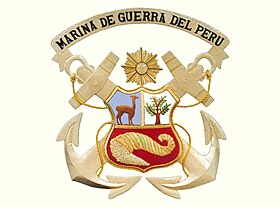Peruvian Navy
| Peruvian Navy Marina de Guerra del Perú |
|
|---|---|

Coat of arms of the Peruvian Navy
|
|
| Active | 8 October 1821 - today |
| Country | Peru |
| Allegiance | Ministry of Defense |
| Branch | Navy |
| Size |
25,988 active personnel 51 ships, 33 aircraft |
| Naval Headquarters | Callao Naval Base |
| Patron | Miguel Grau Seminario |
| Anniversaries | October 8 - Navy's Foundation Day and Anniversary of the Battle of Angamos |
| Fleet | 6 Submarine 1 Cruiser 7 Frigate 6 Corvette 2 Landing Ship, Tank 6 River gunboat 2 Training Ship (21 Auxiliaries) |
| Engagements |
Gran Colombia-Peru War |
| Commanders | |
| Commander-in-Chief | Carlos Tijeda |
| Insignia | |
| Naval Ensign |  |
| Naval Jack |  |
| Roundel |  |
| Low-visibility roundel |  |
25,988 active personnel
Gran Colombia-Peru War
War of the Peru-Bolivian Confederation
Chincha Islands War
War of the Pacific
The Peruvian Navy (Spanish: Marina de Guerra del Perú, abbreviated MGP) is the branch of the Peruvian Armed Forces tasked with surveillance, patrol and defense on lakes, rivers and the Pacific Ocean up to 200 nautical miles (370 km; 230 mi) from the Peruvian littoral. Additional missions include assistance in safeguarding internal security, conducting disaster relief operations and participating in international peacekeeping operations.
The Marina de Guerra del Perú celebrates the anniversary of its creation in 1821 on October 8 and also commemorates the decisive Battle of Angamos, the final part of the naval campaign of the War of the Pacific between Peru and Chile at the end of 1879.
The Marina de Guerra del Perú was established on 8 October 1821 by the government of general José de San Martín. Its first actions were undertaken during the War of Independence (1821–1824) using captured Spanish warships. Shortly afterwards it was engaged in the war against the Gran Colombia (1828–1829) during which it conducted a blockade against the seaport of Guayaquil and then helped with the occupation of this city by Peruvian forces. It saw further action during the wars of the Peru-Bolivian Confederacy (1836–1839) and during the Chincha Islands War with Spain (1866). The breakout of the War of the Pacific (1879–1883) caught the Peruvian Navy unprepared and with inferior forces in comparison with the Chilean Navy. Even so, hit-and-run tactics carried out by Peruvian Admiral Miguel Grau, commander of the ironclad Huáscar, delayed the Chilean advance by six months until his death and defeat at the Battle of Angamos.
...
Wikipedia
